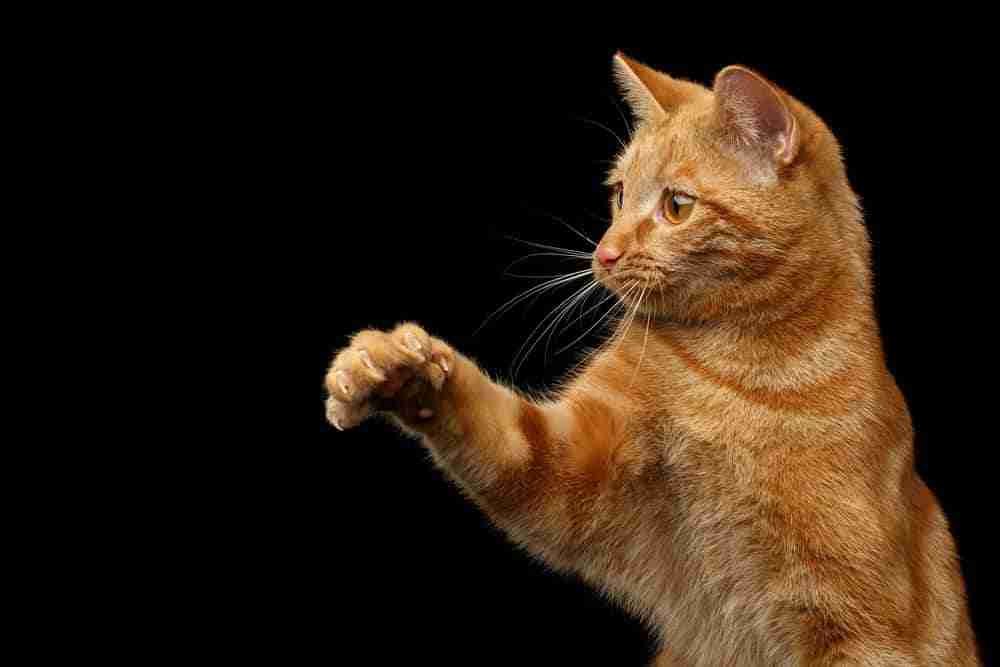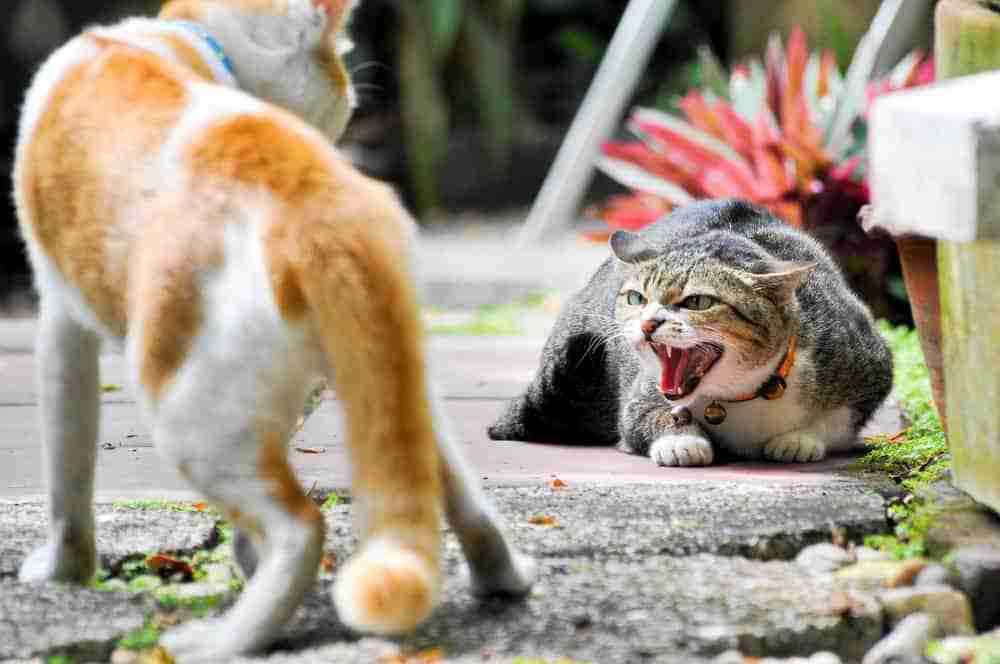Have you got an orange cat? Do you find them to be aggressive? Are orange tabby cats aggressive by nature? These are some of the common questions that come up about orange-colored cats. It is almost because people assume that a fiery-colored coat equals a fiery temperament!
Let’s check out whether science has any answers, find out what might make cats aggressive, and identify if there are any fixes for aggressive or crazy cats!
Does Science Suggest Orange Tabbies Are Aggressive?
Obviously, the science in this area is limited. Running studies into such topics as whether orange cats have different characteristics to black cats simply doesn’t really carry much scientific interest. But, we can draw on some studies into cat behavior that might allow us to draw some conclusions. Here is what the available science says :
When handled, female cats tend to be more aggressive than male cats.
First up we have a study dating back to 2015 that explored how aggressive cats might be when handled based on sex and color. Now, if orange cats were more aggressive than other cats you might expect this study to pinpoint this finding.
The study looked at three different handling situations and asked 1400 cat guardians to comment on how their cats behaved in such circumstances. So, one situation might be how did they behave handled at vets and another might reference daily handling in an environment the cat was familiar with.
The results were interesting. The overall conclusion was that female cats are slightly more aggressive than male cats (but not by a lot), and that gray and white female cats complained the most, black and white females and orange females dead-heated in second place and calico females came in third.
So, females seem to be slightly more aggressive than males when handled and neither male nor female orange cats came in at the top spot.

Orange cats are more likely to be male cats.
So if females are a little more aggressive than males when handled and female orange cats come in joint second place then maybe there are loads of female orange tabby cats that are giving this impression that orange tabby cats are crazy?
No, this 2009 study into the genetics of cats found that the orange coat color is actually genetically linked to the chromosomes that control sex. Essentially, 80% of all orange tabby cats are males.
So, if most red tabby cats are male and males don’t complain as much as females when handled and female orange cats aren’t necessarily the worst – then can we thoroughly dispel the idea that ginger tabby cats are more aggressive than other cats? Perhaps!
Larger cats are found to be more aggressive
Not so fast! Other studies have found that larger cats tend to be more aggressive than smaller cats – to each other. Basically, larger males tend to try to aggressively dominate smaller males to increase their chances of reproduction.
The study is not suggesting that larger cats are more aggressive to people than smaller cats but in a cat-on-cat situation, bigger cats generally throw their weight about more!
What is interesting about this is the potential correlation between male cats being bigger than females and females complaining more when handled as discussed earlier. Can we draw the conclusion that larger males are more confident and willing to take risks due to their size? Are they so used to being alpha types that actually they are more relaxed with approaching and being handled by people? Therefore maybe orange tabby cats that are mainly male dispel the myth that these cats are more aggressive than others – with people?
Orange male cats are larger than male cats of other colors.
So potentially, orange tabby cats are not as aggressive with people as other cats. Could they have a fiery reputation from other factors? Well, maybe.
There is also data available from this study and this study that independently verify that orange male cats are usually bigger than male cats of all other colors!
So putting it together – larger cats are more aggressive to other cats than smaller cats and orange tabby cats that tend to be male also seem to be bigger than male cats of any other color!
Have we got a situation where orange tabby cats are likely to be aggressive to other cats but are actually chilled and friendly to people due to their confident risk-taking attitude?
Is this why some people consider orange tabby cats are more affectionate than other cats but then you have this interesting idea that orange cats are more aggressive?

What Makes Individual Cats Aggressive?
What is clear from the science is that there are not any absolutes when it comes to cat aggression based on sex or color. There are some interesting general traits but that is all they are – “general”.
We can’t say with a high degree of certainty that black female cats are crazy or that orange tabby cats are lazy and dumb. So if you have an orange cat that is aggressive what might be the cause?
Aggression in cats can be toward other cats, people, or even other pets in the home. In the wild most animals are aggressive if they need to protect territory or offspring or if they feel they are coming under attack.
There are several recognized categories of aggression in cats: redirected aggression, fear-induced aggression, intact cat aggression, petting aggression, predatory aggression, and pain or health-induced aggression.
Redirected Aggression
Redirected aggression is borne of frustration. Say your cat sees a local cat through a window. They may feel their territory is invaded and become aggressive – but the window blocks their response. You walk in the room and pet your cat at which point your cat in a blind aggressive move swats you viciously! This is redirected aggression that is due to frustration rather than your approach.
Fear Induced Aggression
Fear-induced aggression is maybe when you take your cat to the vet and the cat suddenly reverts to being a monster – because they are fearful of the surroundings, smell, strangers, or potentially remember a previous visit which they associate with pain and bad memories.
Intact Cat Aggression
Intact cat aggression is the aggression associated with mother cats defending kittens or tom cats protecting territories – natural, hormonal behaviors.
Petting Aggression
Petting aggression occurs when a cat tolerates a person petting them but then finally runs out of patience and basically signals “stop”. Cats have personalities and they are very varied. Some cats appreciate petting and want as much as possible and others are simply not interested and will signal as such.
Predatory Or Play Aggression
Predatory or play aggression is the hunter instincts in the cat turned up to a high volume by people mishandling that cat at an earlier age. Basically, a cat that goes over the top and hunts your feet because you taught it to hunt or lashes out at your hands because as a kitten you played with them barehanded and now they are grown up and can play more powerfully!
Pain Induced Aggression
Pain-induced aggression is really straightforward. Your cat is suffering and doesn’t want any attention. In fact, it is so bad it will lash out if touched – this can happen even with the sweetest cat. Pain is a big motivator. And then there are other health-induced aggressive behaviors. Your cat might actually have a health problem like hypothyroidism, osteoarthritis, bad teeth or just have neurological issues.

Can Aggressive Cats Be Rehabilitated?
If you have an aggressive orange tabby cat you may, having read this, have a better idea about what may be causing their aggressive moments.
If the aggression is just ongoing at every interaction with everyone and everything then a vet visit to rule out health issues is probably the first step.
The next step is to get your cat spayed or neutered to eliminate any intact cat aggression and to generally calm them down if you haven’t had them snipped already.
If your cat uses aggression to signal handling time is over then learn to recognize the signals and back off – don’t force the issue. The cat will not moderate their behavior by experiencing more of the behavior that upsets them! They will continue to lash out until given an opportunity to escape.
All other types of aggression can often, over time, be moderated by giving the cat release of energy through daily play activity. Basically, give the cat some stimulating chase or play activity and wear them out to the point they don’t have the energy or inclination to start aggressive behavior!
Are Orange Tabby Cats Aggressive?
There is nothing in science to say that orange tabby cats are more aggressive than other cats toward people. In fact, the science might suggest that they are good-natured toward people but more likely to be dominant toward other cats – which may make them slightly more likely to be aggressive to competing cats.
However, aggressive behavior by any cat is more likely to be related to the immediate environment the individual cat finds themselves in and the state of their health rather than a breed, color, or genetic reasons. As a rule, are orange tabby cats aggressive? No, there is nothing to indicate they are.
